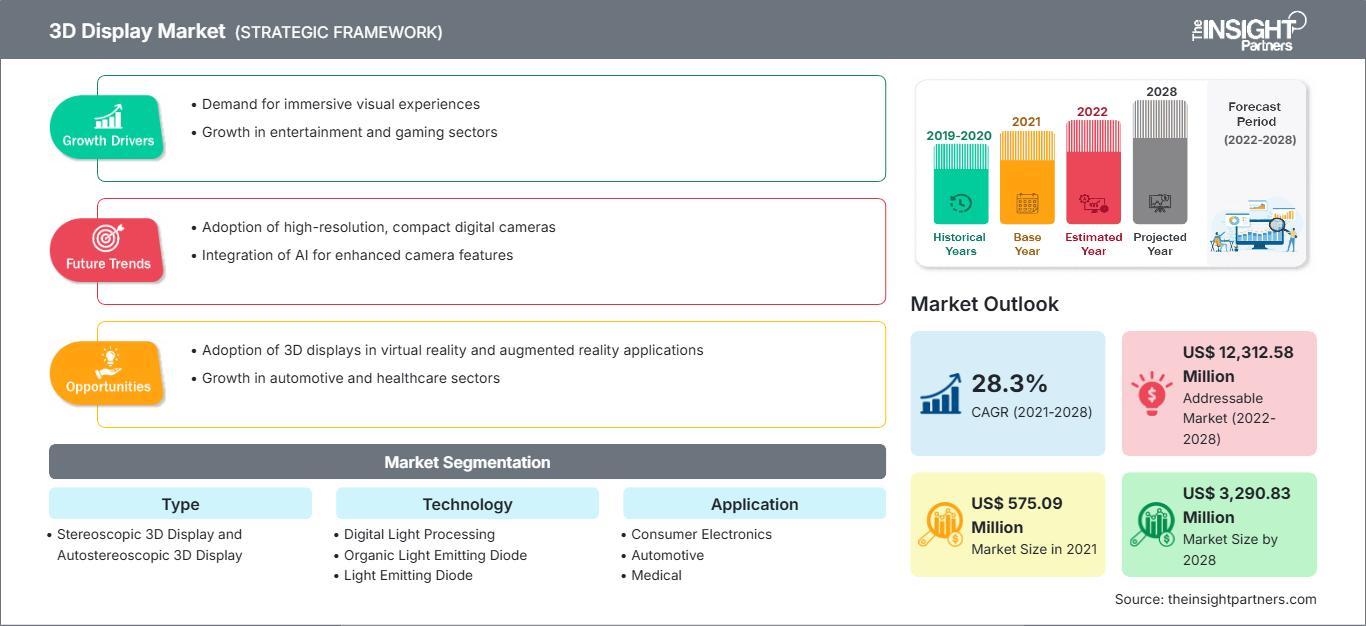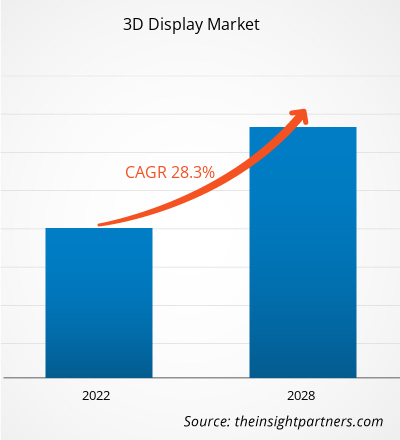Le marché de l'affichage 3D était évalué à 575,09 millions de dollars américains en 2021 pour atteindre 3 290,83 millions de dollars américains en 2028 ; il devrait enregistrer un TCAC de 28,3 % entre 2021 et 2028.
L'électronique grand public, l'automobile, le médical, l'armée et la défense, l'industrie, les médias et le divertissement, ainsi que les jeux vidéo font partie des marchés potentiels pour les écrans 3D. De plus, la croissance des secteurs du divertissement et des jeux vidéo a eu un impact positif sur le marché de l'affichage 3D, car le nombre d'écrans de cinéma a considérablement augmenté, soit environ 125 000 en 2021, et ils ont commencé à fonctionner sur une plateforme numérique à l'échelle mondiale. De plus, l'adoption croissante de la réalité augmentée dans diverses applications médicales, visant à améliorer la vision des chirurgiens, à réduire le temps opératoire et à faciliter la planification préopératoire, crée des opportunités pour le marché de l'affichage 3D. Par exemple, en mai 2020, Ocutrx Vision Technologies, LLC a annoncé le développement de son nouveau système de visualisation chirurgicale, « Ocutrx OR-Bot », équipé d'un écran 3D 8K pour la commande des instruments chirurgicaux. Cependant, les investissements continus, notamment dans les solutions d'affichage 3D autostéréoscopiques, et la multiplication des partenariats entre acteurs du marché et utilisateurs finaux pour développer des systèmes d'affichage 3D holographiques et volumétriques avancés pour un large éventail d'applications, comptent parmi les facteurs de croissance du marché mondial de l'affichage 3D.
Vous bénéficierez d’une personnalisation sur n’importe quel rapport - gratuitement - y compris des parties de ce rapport, ou une analyse au niveau du pays, un pack de données Excel, ainsi que de profiter d’offres exceptionnelles et de réductions pour les start-ups et les universités
Marché de l'affichage 3D: Perspectives stratégiques

-
Obtenez les principales tendances clés du marché de ce rapport.Cet échantillon GRATUIT comprendra une analyse de données, allant des tendances du marché aux estimations et prévisions.
Impact de la pandémie de COVID-19 sur le marché de l'affichage 3D
La crise de la COVID-19 a touché les industries du monde entier, et l'économie mondiale a été la plus durement touchée en 2020, et cette situation devrait se poursuivre en 2021. L'épidémie a créé d'importantes perturbations dans les secteurs primaires tels que l'automobile, la vente au détail et l'électronique grand public. Le fort déclin des industries de l'électronique et de la fabrication a un impact sur la croissance du marché mondial de l'affichage 3D. L'Amérique du Nord est l'une des régions les plus favorables à l'adoption et à la croissance des nouvelles technologies grâce aux politiques gouvernementales de soutien visant à stimuler l'innovation, à la présence d'une vaste base industrielle et à un pouvoir d'achat élevé, en particulier dans les pays développés comme les États-Unis et le Canada. L'Amérique du Nord abrite un grand nombre d'entreprises manufacturières et technologiques, et l'impact de l'épidémie de COVID-19 a donc été assez grave jusqu'à la mi-2021. La région s'attend à une reprise du marché et à une amélioration économique grâce aux campagnes de vaccination contre la COVID-19.
Aperçu du marché – Marché de l'affichage 3D
Nombre croissant de partenariats industriels pour stimuler la croissance du marché
Les principaux domaines d'application actuels des écrans 3D sont le marketing et la publicité. Le médical, l'automobile et la défense devraient figurer parmi les secteurs potentiels des écrans 3D. Le nombre de domaines d'application potentiels des technologies d'affichage 3D pourrait être sans précédent, en fonction de la croissance positive et du développement technologique du marché.
Informations basées sur le type
Selon le type, le marché de l'affichage 3D est segmenté en écrans 3D stéréoscopiques et en écrans 3D autostéréoscopiques. Le segment des écrans 3D autostéréoscopiques détenait une part de marché plus importante en 2021.
Les acteurs du marché de l'affichage 3D se concentrent principalement sur le développement de produits avancés et efficaces.
- En avril 2021, AUO a lancé une superbe série d'écrans ALED au salon Touch Taiwan 2021, présentant une technologie et des applications micro LED de pointe.
- En septembre 2021, l'écran extensible de Samsung peut transformer du contenu 2D en scènes 3D animées.
Aperçu régional du marché de l'affichage 3D
Les tendances régionales et les facteurs influençant le marché de l'affichage 3D tout au long de la période de prévision ont été analysés en détail par les analystes de The Insight Partners. Cette section aborde également les segments et la géographie du marché de l'affichage 3D en Amérique du Nord, en Europe, en Asie-Pacifique, au Moyen-Orient et en Afrique, ainsi qu'en Amérique du Sud et en Amérique centrale.
Portée du rapport sur le marché de l'affichage 3D
| Attribut de rapport | Détails |
|---|---|
| Taille du marché en 2021 | US$ 575.09 Million |
| Taille du marché par 2028 | US$ 3,290.83 Million |
| TCAC mondial (2021 - 2028) | 28.3% |
| Données historiques | 2019-2020 |
| Période de prévision | 2022-2028 |
| Segments couverts |
By Type
|
| Régions et pays couverts |
Amérique du Nord
|
| Leaders du marché et profils d'entreprises clés |
|
Densité des acteurs du marché de l'affichage 3D : comprendre son impact sur la dynamique des entreprises
Le marché de l'affichage 3D connaît une croissance rapide, portée par une demande croissante des utilisateurs finaux, due à des facteurs tels que l'évolution des préférences des consommateurs, les avancées technologiques et une meilleure connaissance des avantages du produit. Face à cette demande croissante, les entreprises élargissent leur offre, innovent pour répondre aux besoins des consommateurs et capitalisent sur les nouvelles tendances, ce qui alimente la croissance du marché.

- Obtenez le Marché de l'affichage 3D Aperçu des principaux acteurs clés
- Analyse historique (2 ans), année de base, prévision (7 ans) avec TCAC
- Analyse PEST et SWOT
- Taille du marché Valeur / Volume - Mondial, Régional, Pays
- Industrie et paysage concurrentiel
- Ensemble de données Excel
Rapports récents
Rapports connexes
Témoignages
Raison d'acheter
- Prise de décision éclairée
- Compréhension de la dynamique du marché
- Analyse concurrentielle
- Connaissances clients
- Prévisions de marché
- Atténuation des risques
- Planification stratégique
- Justification des investissements
- Identification des marchés émergents
- Amélioration des stratégies marketing
- Amélioration de l'efficacité opérationnelle
- Alignement sur les tendances réglementaires






















 Obtenez un échantillon gratuit pour - Marché de l'affichage 3D
Obtenez un échantillon gratuit pour - Marché de l'affichage 3D